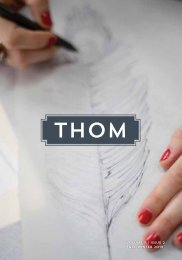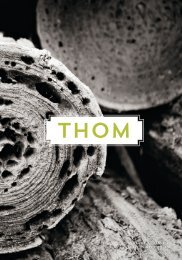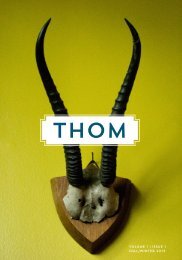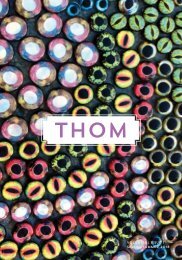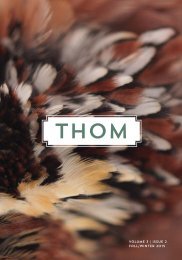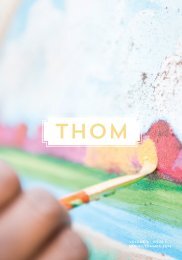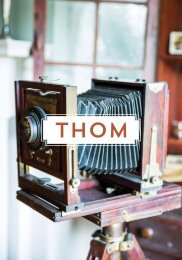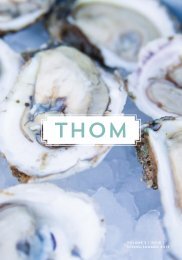THOM 14 | Fall/Winter 2020
You also want an ePaper? Increase the reach of your titles
YUMPU automatically turns print PDFs into web optimized ePapers that Google loves.
artist
“There is also emotional migration. How do you
get someone to change their thinking from one
point of view to another?”
“I usually hear them before I see them,” says
artist Thomas Swanston, who has lived in the
path of these migratory flocks for more than four
decades. Face turned to the sky during these few
weeks of the sandhill cranes’ pit stop, Swanston
often observes their mesmerizing practice of
“kettling”—spiraling upward in tight circular
patterns as they crest among thermal updrafts.
“They come right up over the house, swirling
like a gyre. I’m just fascinated by their rhythm.”
For Swanston the cranes are more than
an ornithological marvel; they are muses.
Emulating the endless chromatic variations
of the sky, his massive paintings invariably
feature these birds in flight, traveling from one
end of the canvas to the other and beyond. It is
an inspiration rooted in nature’s ancient cycles:
Sandhill cranes have existed on the planet for
at least ten million years and have followed the
same migratory path for the past ten millennia.
(A small population does live year-round in the
Okefenokee Swamp.)
To take photographs of the birds that he later
projects onto canvas, Swanston travels to
Nebraska’s Central Platte River Valley, where
birders gather each spring to observe the
spectacle of 600,000 sandhill cranes converging
in the broad shallows. Covid-19 left 2020’s
homecoming unwitnessed (“There’s no way
to socially distance when you’re shoulder to
shoulder in a bird stand,” Swanston says, sighing),
though the cranes’ annual journey continues to
be meaningful to its now remote observers.
“We can use migration as a theoretical
framework in a multitude of ways,” Swanston
says. “There is the physical distance covered, the
pattern made over and over again. There is also
emotional migration: How do you get someone
to change their thinking from one point of view
to another?”
While the cranes pursue their circular course,
Swanston’s career path has been more linear:
Formally trained at New York City’s Studio
School, he received his M.F.A. from Parsons
School of Design, where he met his wife and
partner-in-art, Gail Foster. Together they
eschewed the experimental movements of their
peers and followed the tradition of the Hudson
River School, adopting a rigor and technique still
embedded in their work.
6





